2. What should I know before I use Neupro®?
Do not use if you have ever had an allergic reaction to Neupro® or any of the ingredients
listed at the end of the CMI. Do not use if you need to have an MRI or cardioversion.
Talk to your doctor if you have any other medical conditions, take any other medicines,
or are pregnant or plan to become pregnant or are breastfeeding. For more information, see Section
2. What should I know before I use Neupro®? in the full CMI.
3. What if I am taking other medicines?
4. How do I use Neupro®?
A Neupro® patch is applied to the skin once a day for 24 hours and is then replaced
around the same time every day. The dose varies from patient to patient. More instructions
can be found in Section
4. How do I use Neupro®? in the full CMI.
5. What should I know while using Neupro®?
|
Things you should do
|
Remind any doctor, dentist or pharmacist you visit that you are using Neupro®.
Contact your doctor if you find your symptoms worsen. For example, some people taking
Neupro® to treat Restless Legs Syndrome find their symptoms may start earlier in the
day than usual or be more intense.
Contact your doctor if you notice any problems with your vision or have a serious
skin reaction.
|
|
Things you should not do
|
Do not stop using this medicine or lower the dose, without first checking with your
doctor.
Do not cut Neupro® patches into pieces
Do not give your medicine to anyone else.
|
|
Driving or using machines
|
If you feel very drowsy, or experience episodes of falling asleep suddenly without
feeling sleepy, do not drive or operate machinery or perform any other dangerous activities,
and contact your doctor.
|
|
Drinking alcohol
|
Tell your doctor if you drink alcohol. Combining Neupro® and alcohol can make you
more drowsy. Your doctor may suggest you avoid alcohol while you are being treated
with Neupro®.
|
|
Looking after your medicine
|
Keep your patches in their package until it is time to use them.
Store below 30°C in a cool dry place away from moisture, heat or sunlight.
Keep Neupro® out of reach of children.
|
6. Are there any side effects?
Common side effects: dizziness, lightheadedness, vertigo, abnormal movements e.g. muscle twitching or
spasms, sleep issues, unusual dreams, nightmares, application site reactions (itching
or redness), sweating, feeling tired or weak, hiccups, nausea, vomiting, constipation,
indigestion, dry mouth, headache, swelling of legs or feet, feeling weak and tired
or weight loss.
Serious potential side effects: hallucinations, compulsive behaviour, psychotic disorders including abnormal thinking
about reality and behaviour, confusion, disorientation, allergic reaction (shortness
of breath, wheezing or difficulty breathing, swelling of the face and lips, tongue
or other body parts, rash, itching or hives on the skin), irregular heartbeat, increased
heart rate (palpitations), involuntary muscle spasms (seizure, convulsion), loss of
consciousness, visual disturbances such as seeing colours or lights or blurred vision,
falling, fainting.
For more information, including what to do if you have any side effects, see Section
6. Are there any side effects? in the full CMI.
Active ingredient(s):
rotigotine (pronounced "roe-TIG-oh-teen")
Full Consumer Medicine Information (CMI)
This leaflet provides important information about using Neupro®. You should also speak to your doctor or pharmacist if you would like further information
or if you have any concerns or questions about using Neupro®.
Where to find information in this leaflet:
1. Why am I using Neupro®?
Neupro® contains the active ingredient rotigotine. Neupro® belongs to a group of medicines called non-ergot dopamine agonists which stimulate
dopamine receptors in the brain to increase the effects of dopamine.
Neupro® is used in the treatment of Parkinson’s disease and Restless Legs Syndrome
(RLS).
Parkinson’s disease
This is a disease of the nervous system that mainly affects body movement. The main
symptoms are shaking (tremor), muscle stiffness and slow unsteady movement. If untreated,
Parkinson’s disease can cause difficulty in performing daily activities.
Parkinson’s disease is caused by the brain not making enough of a chemical called
dopamine.
Dopamine helps the brain to control muscle movement. When too little dopamine is produced
slowness of movement results.
Restless Legs Syndrome (RLS)
RLS is a condition characterised by unpleasant sensations in the legs and the irresistible
urge to move in an effort to relieve these feelings. There is a sense of uneasiness,
restlessness, and itching often accompanied by twitching and pain in the legs when
sitting or lying down, especially in bed at night. Occasionally the arms may also
be affected. RLS is thought to be due to insufficient dopamine levels in the brain.
2. What should I know before I use Neupro®?
Warnings
Do not use Neupro® if:
You are allergic to rotigotine, sodium metabisulfite or any of the ingredients listed
at the end of this leaflet.
Always check the ingredients to make sure you can use this medicine.
You need to have magnetic resonance imaging (MRI) (method to visualise internal organs
and tissues of the body) or cardioversion (treatment of an abnormal heart rhythm).
You must take your Neupro® patch off before the procedure. You can put a new patch
on after the procedure.
The packaging is torn or shows signs of tampering.
If any of the above applies to you (or you are not sure), talk to your doctor or pharmacist
before using Neupro®.
Check with your doctor if you:
Have any other medical conditions, including:
liver problems
low or high blood pressure
heart problems
mental or sleep disorders
compulsive disorders such as gambling or a high sex drive
problems with your sight
take any medicines for any other condition
During treatment, you may be at risk of developing certain side effects. It is important
you understand these risks and how to monitor for them. See additional information
under Section
6. Are there any side effects?
Pregnancy and breastfeeding
Check with your doctor if you are pregnant or intend to become pregnant.
The effects of Neupro® on pregnancy and the unborn child are not known. Neupro® should
not be used during pregnancy.
Talk to your doctor if you are breastfeeding or intend to breastfeed.
Neupro® is not recommended if you are breastfeeding, as it is likely to reduce the
amount of milk you produce. Neupro® may also pass into your breast milk and affect
your baby. If your doctor says you need to use Neupro®, you should stop breastfeeding.
Children and Adolescents
Do not give this medicine to a child or adolescent. The safety and effectiveness in
children and adolescents has not been established.
3. What if I am taking other medicines?
Tell your doctor or pharmacist if you are taking any other medicines, including any
medicines, vitamins or supplements that you buy without a prescription from your pharmacy,
supermarket or health food shop.
Some medicines may interfere with Neupro® and affect how it works.
some other medicines used to treat Parkinson’s disease or Restless Legs Syndrome
medicines used to treat depression or mental illness
medicines used to calm you or help you sleep
metoclopramide, a medicine used to treat nausea and vomiting.
Check with your doctor or pharmacist if you are not sure about what medicines, vitamins
or supplements you are taking and if these affect Neupro®.
4. How do I use Neupro®?
How much to take / use
Follow all directions given to you by your doctor carefully. They may differ from the information contained in this leaflet.
The dose varies from patient to patient. Your doctor may start you on a low dose of
Neupro® first and slowly increase the amount of medicine until you are taking enough
to control your condition.
Parkinson's Disease
The usual starting dose is one 2 mg/24-hour patch or one 4mg/24-hour patch daily.
This dose will be increased gradually in steps of 2 mg/24 hours until the right (maintenance)
dose for your needs is reached.
Restless Legs Syndrome
The usual starting dose is one 1 mg/24 hour patch. If necessary, this dose will be
increased gradually in steps of 1 mg/24 hours until the right (maintenance) dose for
your needs is reached. The maximum dose is 3 mg/24 hour.
Continue taking Neupro for as long as your doctor tells you. This medicine helps to control your condition but does not cure it. It is important
to keep using your medicine even if you feel well.
When to take / use Neupro®
You should stick a Neupro® patch onto the skin once a day. You should leave the patch
on your skin for 24 hours and then replace it with a new one. Make sure that you take
the old patch off before sticking on the new one. You should replace the patch at
around the same time every day.
Where to apply the patch
Put the sticky side of the patch onto clean, dry, healthy skin on one of the following
areas at a time:
shoulder
upper arm
belly
thigh
hip
flank (your side, between your ribs and your hip).
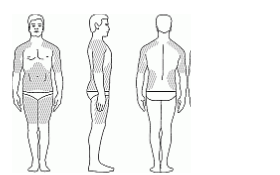
To help avoid skin irritation, stick the patch onto a different area of skin each
day (for example, on the right side of your body one day, then on the left side the
next day and on your upper body one day, then on your lower body). You should not
stick Neupro® on the same area of skin twice within 14 days.
Things to remember
You should put the patch where it will not be rubbed by tight clothing which could make it fall off.
If you need to stick the patch to a hairy area of skin, you must shave the area at least three days before sticking the patch there.
Do not stick the patch on broken skin or on skin that is red, irritated or damaged.
Do not use creams, oils, lotions, powders or other skin products on the area of skin you will be sticking the patch on or near a patch you are already
wearing. The patch may become loose.
Bathing, showering and exercising should not affect how Neupro® works. There is no need to remove the patch when bathing,
showering, swimming or exercising. Nevertheless, check that the patch has not fallen
off after such activities.
You should avoid external heat (for example excessive sunlight, saunas, hot baths, heating pads or hot-water bottles)
on the area of the patch.
If the patch has irritated your skin, you should keep that area of skin covered from the sun and solarium exposure, as it may cause changes in the colour of the skin.
How to apply Neupro®
Each patch is packed in a sachet containing the medicine. You should stick Neupro®
onto your skin as soon as you have opened the sachet and removed the protective liner.
1. To open the sachet, hold the two sides of the sachet. Peel apart the foil and open
the sachet.
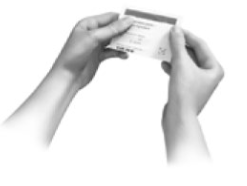
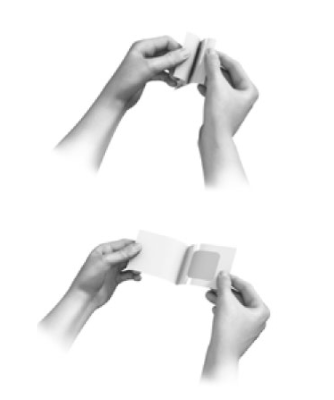
2. Take the patch out of the sachet.
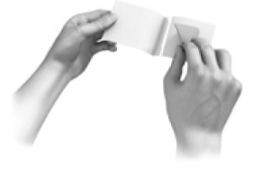
3. The sticky side of the patch is covered by a transparent protective liner. Hold the
patch in both hands with the protective liner facing you.
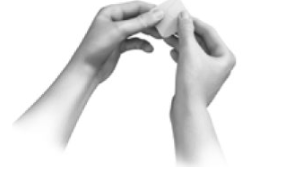
4. Bend the patch in half so that the S-shaped break in the liner opens.

5. Peel off one side of the protective liner. Don’t touch the sticky side of the patch
with your fingers.
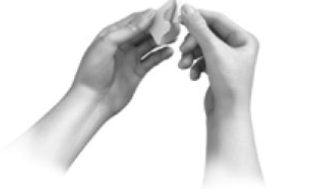
6. Hold the other half of the rigid protective liner and put the sticky surface of the
patch onto your skin. Press the sticky side of the patch firmly into place.
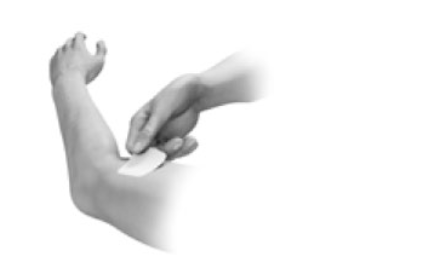
7. Fold back the other half of the patch and remove the other side of the protective
liner.
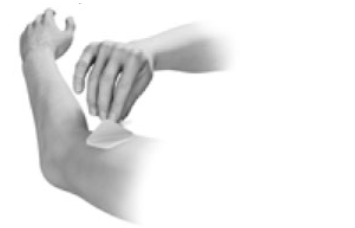
8. Press the patch down firmly with the palm of your hand for about 20 - 30 seconds to
make sure the patch is touching the skin and that the edges stick well.
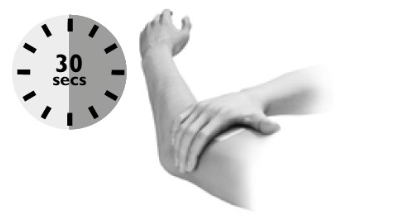
It is important to ensure you press the patch firmly for 20 – 30 seconds.
Wash your hands with soap and water immediately after handling the patch.
How to change Neupro®
Before you put on a new patch, slowly and carefully peel off the used patch.
Gently washing the area with warm water and mild soap should remove any adhesive that
stays on your skin after you remove the patch.
You can also use a small amount of baby oil to remove any adhesive that won’t wash
off.
Do not use alcohol or other dissolving liquids such as nail polish remover or other
solvents as these may irritate your skin.
If the patch falls off, a new patch should be applied for the rest of the day, then
replace the patch at the same time as usual.
If you forget to use Neupro®
Neupro® should be used regularly at the same time each day. If you miss your dose
at the usual time, remove the old patch and use a new patch as soon as you remember.
If you have forgotten to stick on a new patch after removing the old one, use a new
patch as soon as you remember. On the following day you should use a new patch at
the usual time.
Do not take a double dose to make up for the dose you missed.
If you use too much Neupro®
If you think that you have used too much Neupro® (for example you have used more patches
than your doctor told you to), you may need urgent medical attention.
You should immediately:
phone the Poisons Information Centre
(by calling
13 11 26), or
contact your doctor, or
go to the Emergency Department at your nearest hospital.
Using higher dosages of Neupro® than your doctor has prescribed may cause nausea,
vomiting, low blood pressure, fast heart beats, hallucinations, confusion or extreme
sleepiness.
You should do this even if there are no signs of discomfort or poisoning.
5. What should I know while using Neupro®?
Things you should do
Call your doctor straight away if you:
Find your symptoms worsen. For example some people taking Neupro® to treat Restless
Legs Syndrome find their symptoms may start earlier in the day than usual or be more
intense.
Become pregnant while using this medicine.
If you notice any problems with your vision.
If you have a skin reaction which lasts for more than a few days, if a skin reaction
becomes serious, or if the skin reaction spreads outside the area covered by the patch,
please contact your doctor.
Like with every patch or bandage, Neupro can cause skin reactions. These are normally
mild and usually affect only the area of skin the patch has been on.
Remind any doctor, dentist or pharmacist you visit that you are using Neupro®.
Things you should not do
Do not stop using this medicine or lower the dose, without first checking with your
doctor. Do not let yourself run out of medicine over the weekend or on holidays. If
you stop taking it suddenly your condition may worsen or you may have unwanted side
effects.
Do not cut Neupro® patches into pieces.
Do not give your medicine to anyone else, even if their symptoms seem similar to yours
or if they have the same condition as you.
Do not use Neupro® to treat any other complaints unless your doctor tells you to.
Driving or using machines
Be careful before you drive or use any machines or tools until you know how Neupro®
affects you.
Neupro® may make you feel very drowsy and may cause some people to fall asleep suddenly
without any apparent warning of sleepiness.
If you feel very drowsy, or experience episodes of falling asleep suddenly without
feeling sleepy, do not drive or operate machinery or perform any other dangerous activities,
and contact your doctor.
Drinking alcohol
Tell your doctor if you drink alcohol.
Combining Neupro® and alcohol can make you more drowsy. Your doctor may suggest you
avoid alcohol while you are being treated with Neupro®.
Looking after your medicine
Keep your patches in their package until it is time to use them.
Store below 30°C.
Keep Neupro® out of reach of children.
Follow the instructions in the carton on how to take care of your medicine properly.
Store it in a cool dry place away from moisture, heat or sunlight; for example, do
not store it:
in the bathroom or near a sink, or
in the car or on window sills.
Keep it where young children cannot reach it.
When to discard your medicine
Used patches still contain active ingredient, which may be harmful to others. Fold
the used patch with the sticky side inwards. Put the patch in the original sachet
and then throw it away safely, out of the reach of children.
Do not flush them down the toilet, nor place them in liquid waste disposal systems.
Getting rid of any unwanted medicine
If you no longer need to use this medicine or it is out of date, take it to any pharmacy
for safe disposal.
Do not use this medicine after the expiry date.
6. Are there any side effects?
All medicines can have side effects. If you do experience any side effects, most of
them are minor and temporary. However, some side effects may need medical attention.
See the information below and, if you need to, ask your doctor or pharmacist if you
have any further questions about side effects.
Less serious side effects
Serious side effects
Tell your doctor or pharmacist if you notice anything else that may be making you
feel unwell.
Other side effects not listed here may occur in some people.
Reporting side effects
After you have received medical advice for any side effects you experience, you can
report side effects to the Therapeutic Goods Administration online at
www.tga.gov.au/reporting-problems . By reporting side effects, you can help provide more information on the safety of
this medicine.
Always make sure you speak to your doctor or pharmacist before you decide to stop
taking any of your medicines.
7. Product details
This medicine is only available with a doctor's prescription.
What Neupro® contains
|
Active ingredient
(main ingredient)
|
Rotigotine
|
|
Other ingredients
(inactive ingredients)
|
povidone
sodium metabisulfite
DL-α-tocopherol
ascorbyl palmitate
silicone adhesives (BIO-PSA Q7-4301 and BIO-PSA Q7-4201)
Backing layer:
polyester film
silicone
aluminium
colour coated with a pigment layer (titanium dioxide, pigment yellow 95, pigment red
166) and imprinted (pigment red 144, pigment yellow 95, pigment black 7).
Protective liner:
polyester film
fluoropolymer
|
Do not take this medicine if you are allergic to any of these ingredients.
What Neupro® looks like
Neupro® is a transdermal patch that is available in four different strengths:
Neupro® 2 mg/24 h AUST R 131370
Neupro® 4 mg/24 h AUST R 131381
Neupro® 6 mg/24 h AUST R 131382
Neupro® 8 mg/24 h AUST R 131383
1 mg/24 h and 3 mg/24 h transdermal patches are not available in Australia.
The patches are thin and have three layers. They are square shaped with rounded edges.
The outside is tan-coloured and is imprinted with either Neupro® 2 mg/24 h, Neupro®
4 mg/24 h, Neupro® 6 mg/24 h or Neupro® 8 mg/24 h.
Neupro® is available in cartons containing 28 patches, which are individually sealed
in sachets.
Who distributes Neupro®
UCB Pharma
A division of UCB Australia Pty Ltd
Phone: +61 3 9828 1800
This leaflet was prepared in October 2025.